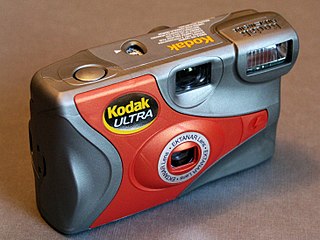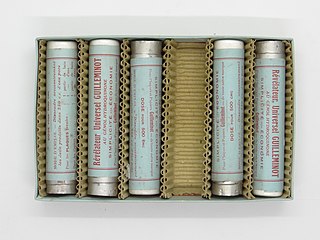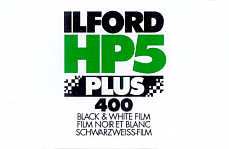| XP2 Super | |
|---|---|
 | |
| Maker | Ilford Photo |
| Speed | 400/27° |
| Type | B&W print |
| Process | Chromogenic |
| Format | 35mm, 120, disposable camera |
| Exposure latitude | EI 50/18° – 800/30° |
| Application | General |
| Introduced | 1998 |
XP is a chromogenic black-and-white film from Ilford Photo. [1] It was launched to great acclaim at photokina in September 1980, and went on sale in January, 1981. It has since progressed through a number of versions, with XP2 Super being the latest. The main competitor of Ilford XP2 Super was Kodak BW400CN, which was discontinued in 2014. As of 2018, Ilford XP2 Super and Fuji Neopan 400CN are the only black & white films on the market that can be developed using the C-41 process.
Chromogenic refers to photographic processes that work by forming a conventional silver image and then replacing it with a dye image. Most films and papers used for color photography today are chromogenic.

Ilford Photo is a UK manufacturer of photographic materials known worldwide for its black-and-white film and papers and chemicals, as previously as its range of Ilfochrome and Ilfocolor colour printing materials, before these were discontinued. Ilfochrome was formerly called Cibachrome, developed in partnership with the Swiss company CIBA-Geigy. Formerly, it published the Ilford Manual of Photography, a comprehensive manual of everything photographic, including the optics, physics and chemistry of photography, along with recipes for many developers.

The Eastman Kodak Company is an American technology company that produces camera-related products with its historic basis on photography. The company is headquartered in Rochester, New York, and is incorporated in New Jersey. Kodak provides packaging, functional printing, graphic communications and professional services for businesses around the world. Its main business segments are Print Systems, Enterprise Inkjet Systems, Micro 3D Printing and Packaging, Software and Solutions, and Consumer and Film. It is best known for photographic film products.
As a chromogenic film, XP2 can scan well because it avoids the limitations of Digital ICE, plus it has a similar exposure latitude to color negative film, so it can be exposed with an exposure index from ISO 50/18° to 800/30° on a single roll and be developed in traditional C-41 processing.
C-41 is a chromogenic color print film developing process introduced by Kodak in 1972, superseding the C-22 process. C-41, also known as CN-16 by Fuji, CNK-4 by Konica, and AP-70 by AGFA, is the most popular film process in use, with most photofinishing labs devoting at least one machine to this development process.
In 2013, Ilford introduced a version of their black-and-white single-use camera which includes 27 exposures of XP2 Super film.

A disposable or single-use camera is a simple box camera meant to be used once. Most use fixed-focus lenses. Some are equipped with an integrated flash unit, and there are even waterproof versions for underwater photography. Internally, the cameras use a 135 film or an APS cartridge.









